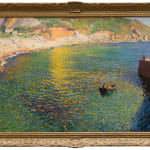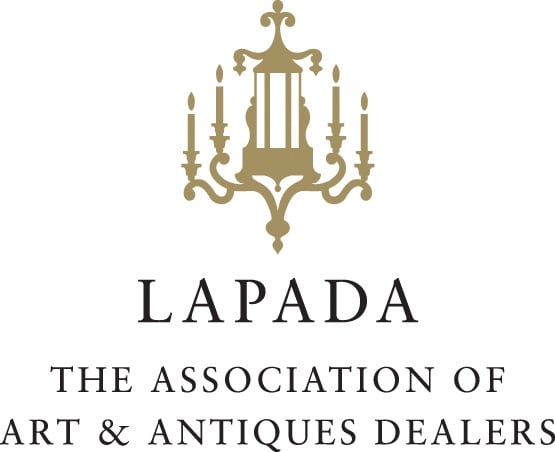Laura Knight 1877-1970
Framed: 119 x 160 cm.; 47 x 63 in.
Lamorna Cove is a remarkable canvas which not only celebrates Cornwall’s enchanting luminosity but also evokes a deep emotional resonance. It stands as a bold declaration of artistic freedom that arose from Laura Knight’s profound connection with the pristine landscape of West Cornwall. Painted from an elevated vantage point beneath Tregurnow Cliff, the painting provides a glorious view across Lamorna cove that remains mostly unchanged today. Several of Knight’s most evocative Cornish landscapes were situated between Lamorna and Portcurno, including cliff-top views. In the present work, Knight diverts her focus solely to the sparkling water of Lamorna’s secluded bay on an unusually large scale. It emphatically marks Knight’s transformation from the restricted palette of her native Yorkshire to the vibrant exuberance that would characterise her Cornish paintings. Moving to Cornwall from Staithes in 1907 with her husband Harold, the impact was immediate. As their contemporary Norman Garstin recalled: ‘...with their advent, there came over their work an utter change in both their outlook and method: they at once plunged into a riot of brilliant sunshine of opulent colour and sensuous gaiety’ (Caroline Fox, Dame Laura Knight, 1988, p. 26).
Knight’s masterful treatment of the sea’s expansive surface employs an almost pointillist technique, where countless individual brushstrokes combine to form a shimmering rhythm that pulses with Mediterranean brilliance. Topographical features guide the eye across the canvas: the protruding jetty, the cluster of white cottages in the upper left quadrant, and the rocky promontories more broadly rendered. In the foreground are swimmers, glimpsed rather than scrutinised, and evoking the liberation from urban constraint that Cornwall represented for Knight and her contemporaries. It bears comparison with the work of Henry Scott Tuke, whose celebrated depictions of male bathers on Cornish beaches had established a visual vocabulary for representing the intersection of youth, beauty, and the natural environment.
Knight’s absorption of French impressionist technique within an English context parallels the achievements of her contemporaries in the Camden Town Group and the New English Art Club. However, her commitment to plein-air observation kept her aligned with the Newlyn School and its philosophy of placing oneself in the landscape and painting directly from nature.
In 1936, Knight would be elected the first woman to the Royal Academy, an achievement secured on such paintings as the present – one of her largest and most spectacular depictions of the Cornish coastline. In her own words, Cornwall brought ‘an ebullient vitality’ that made her ‘want to paint the whole world and say how glorious it was to be young and strong and able to splash with paint.’ (L. Knight, Oil Paint and Grease Paint, London 1936, pp. 169–86).
Laura and Harold Knight lived in Cornwall until 1919 when they moved to London. Lamorna Cove is the last major canvas Laura painted before their departure. Over the following years, Laura would energetically embrace a remarkable range of subjects including theatre and circus performers, gypsies, ballerinas and boxers. During the Second World War she was an official war artist, notably documenting women’s manufacturing contribution to the war effort and depicting the Nuremberg trials. In 1936, she was elected to the Royal Academy and in 1965 was the first woman to be honoured with a retrospective exhibition at the institution.
Her time in Cornwall was an especially fruitful and transformational period, resulting in some of the defining paintings of British Impressionism in the early 20th century. What emanates from her canvases so emphatically is her joyful and physical response to the Cornish landscape. As Laura was to recall of her years in Cornwall, ‘the very bright of life beamed on us. We had never known the joys of youth before. We danced, played games and lived half the night as well as working hard all day’ (Caroline Fox, Dame Laura Knight, 1988, pp. 25).
Provenance
Ian MacNicol, Glasgow (possibly from the artist)
James Sword Esq
Ian MacNicol, Glasgow
Charles Hepburn (proprietor of Red Hackle Scotch Whiskey)
Ian MacNicol, Glasgow
Private collection, Scotland
Peter Nahum at the Leicester Galleries, LondonSotheby's, London, 21 July 2005, lot 20
Private Collection
Exhibitions
London, Royal Academy, Summer Exhibition, 1920, no. 618




